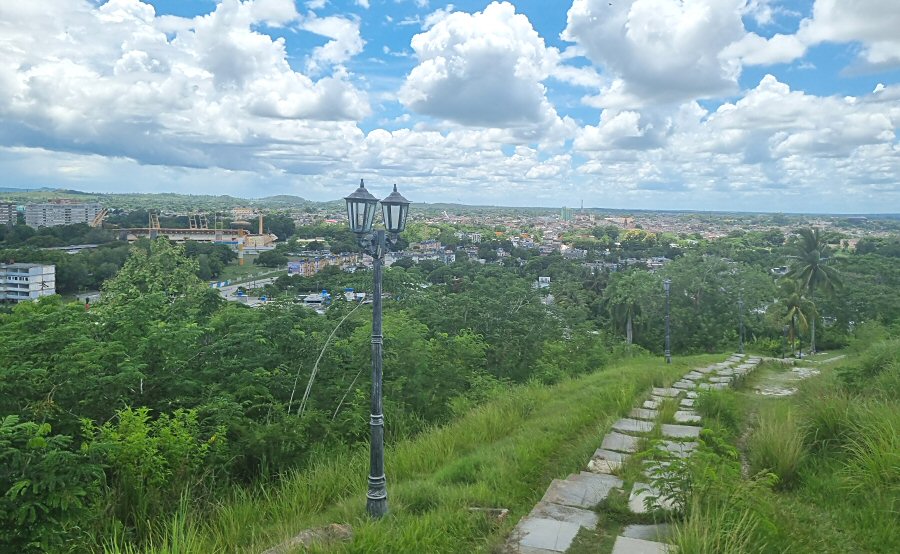
Loma del Capiro
Capiro Hill is a place worth considering both for its geographical location, as one the highest point around the city of Santa Clara, overlooking the entire city, and for its strategic importance in the Battle of Santa Clara, which played a critical role in the victory of the Revolution. Loma del Capiro is the symbol of the struggle between patriots with much less opportunity against the powerful oppressor, crowned with the victory of the patriots.
The hill was named after its former owner, Cristóbal de Moya,
a native of Santa Clara. During a visit to Panama, Cristóbal
noticed that Monte Capiro in Portolebo was very similar to
the one he owned. Upon his return from the trip, he gave the
same name to the hill in Santa Clara.
The site was declared a National Monument in 1990, along
with the Armored Train.
GEOGRAPHICAL SIGNIFICANCE
Loma del Capiro is a geological formation located in
Cretaceous-Tertiary time. It is a part of the Loma del
Capiro Historic-Cultural Park which also includes the
neighboring twin hills known as Dos Hermanas (Two Sisters).
With its height of 176,5 meters, Capiro Hill is the smallest
among the three elevations constituting a whole. The
neighboring hills (Dos Hermanas) are 185,9 and 188,4 meters
above the sea level.
Dos Hermanas is known in scientific circles due to the
discovery of abundant evidence of the Chicxulub meteorite
impacting Earth on its slopes. The Chicxulub impact refers
to a massive meteor that struck the Yucatán Peninsula during
the Cretaceous/Paleogene period and is believed to have
played a significant role in the mass extinction of the
dinosaurs millions of years ago by generating horrific mega
tsunamis, earthquakes, and storms which modeled the
Antillean archipelago. Cuba was particularly affected by the
island's proximity and its elongated structure.
HISTORICAL SIGNIFICANCE
Capiro Hill was a strategic point that played a role in the
victory over Batista's army in the Battle of Santa Clara. On
December 28, 1958, forces under the command of Che Guevara
(approximately 300 poorly armed guerrillas) launched a
campaign to capture Santa Clara, defended by approximately
3,000 army personnel, and to prevent the passage of a train
carrying weapons and ammunition to the east of the island.
Batista’s troops, stationed in Santa Clara, were supported
by the air force, an armored train, artillery, machine guns,
and dozens of armored units. They also held all the city's
high points and strategic positions. Given this disparity in
military forces, Che Guevara adopted a different tactic, and
made a plan to capture Capiro Hill, the highest point of the
city, in the first stage and in the second stage to disable
the armored train loaded with weapons, and then attack the
city.
Thus, the first attack was launched against a group of
soldiers from the armored train which were positioned in the
trenches on the southern slope of the hill. A platoon under
the command of Luis Alfonso Zayas and a part of the Suicide
Platoon under the command of Lieutenant Hugo del Río
advanced towards this area on the hill. However, they
encountered intense mortar and heavy-caliber gunfire. They
were also attacked from the air. The rebels fought all day
on the first day of the attack (December 28, 1958) and
managed to surrender the hill in the early morning hours of
December 29.
After the capture of the Capiro Hill Che Guevara ordered
several members of the Suicide Platoon to join the main
group of rebels as they attacked toward the center of Santa
Clara. He also ordered a small detachment under the command
of Luis Alfonso Zayas to capture soldiers who had escaped or
lost their way from the forces at Loma del Capiro.
The retreating soldiers made their way to the armored train,
but shortly thereafter, the train was derailed by the
rebels, and the railway was destroyed. After a brief clash,
all soldiers in the area, including Colonel Casillas Lumpuy,
surrendered, and the rebels advanced with all their might
toward the city center of Santa Clara. It is said that Che
led the attack from here in the period between the capture
of the hill and the fall of Santa Clara (approximately 24
hours).
TOURISTIC SIGNIFICANCE
Capiro Hill is a popular destination for both locals and
tourists, even except certain day of celebrations. It is a
vantage point for the extraordinary beauty of the Santa
Clara Valley and provides stunning panoramic views of the
city.
The peak is reached by a winding, moderately steep,
step-paved road. You have to climb approximately 200 steps
to reach the peak.
At the peak stands the metallic Monument to the Battle of
Santa Clara. It is the work of the sculptor José Delarra and
erected in 1988. The monument, approximately 10 meters high,
is a mixture of stainless steel and bronze. It consists of weapons of various
calibers pointed at the sky, surrounded by a ring. A
silhouette of Che Guevara is depicted on the ring. The
monument rests on a green marble base. The sculpture
represents the defense of the nation's skies and symbolizes
the will to unite the Cuban nation. The peak is marked by
two flags.
You can see the trenches around, dug by rebel forces
surround the monument.
On the southern slope of the hill, there is a tamarind
plantation that has been preserved and expanded for several
decades. This is the symbolic tree of the city of Santa
Clara and represents its founding. Every July 16th, a
tamarind tree is planted there during a solemn ceremony.
The surrounding lands of the hill have long been a supplier
of fruits, herbs, medicinal products, vegetables and other
products.
Daily 24 hours
Loma del Capiro is reached by following Avenida Liberación, and then through narrow streets where two cars give way to each other. Parking is available.